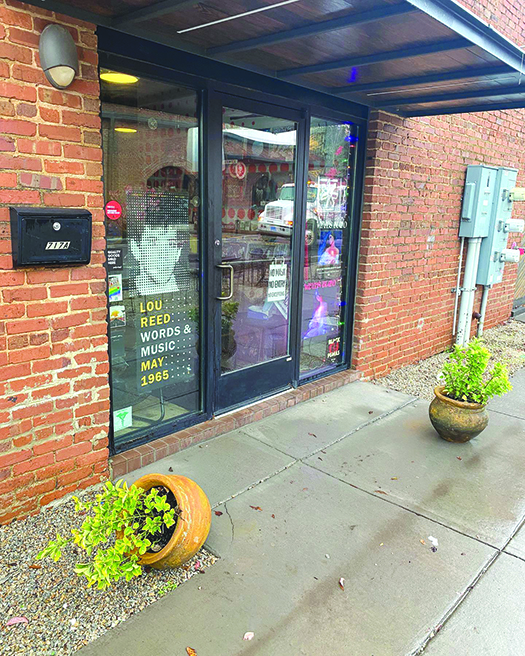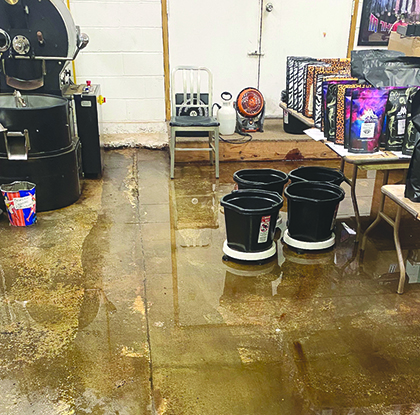BY KENDYL HOLLINGSWORTH
KENDYLH@
OPELIKAOBSERVER.COM
OPELIKA —
Help is on the way following repeated flooding on First Avenue in downtown Opelika.
According to City Engineer Scott Parker, the contracted work is expected to begin as soon as this week and last for up to two weeks.
“We are going to do whatever it takes to eliminate the flooding issue on First Avenue,” said Opelika Mayor Gary Fuller in a statement to The Observer.
The contractor is set to modify parts of a streetscape project the city began in October 2020. A major part of the work will include the installation of a larger receiving inlet, which helps move water through the drainage system.
The planned adjustments come after business owners on the street complained of the repeated flooding. While some have experienced the issue more often than others, at least three businesses suffered significant damages in the Nov. 29 flood — the result of a heavy storm that moved through the area. Mama Mocha’s, 10000 Hz and Sneak & Dawdle were all forced to limit operations the next day or two — or close altogether — as they dealt with the damage.
“This has happened a couple times, and we had to shut down two nights because it was just too wet in there,” said Matt Poirier, owner of Sneak & Dawdle, 10 days after the flood. “We still have the dehumidifiers and fans running when we’re not open, and they’re still collecting water.”
Poirier said Sneak & Dawdle experienced flooding even before the city’s streetscape project, but rarely is it severe. The Nov. 29 flood was an exception, though.
“This last time was by far the worst it’s been for us,” Poirier said. “The water went all the way to the back of the building, which we had not seen before.”

Both Sneak & Dawdle and 10000 Hz have a small step up — less than six inches — at their front entrances. But according to Russ Baggett, owner of 10000 Hz, that small step is likely what prevents more episodes of severe flooding.
Still, Baggett said it’s not feasible to keep all the store’s inventory off the ground in case of any floods.
“There’s only so much space in here, you know?” he said. “The way that our cabinets are — we didn’t build cabinets designed for worrying about flooding regularly.”
And since the shop has grown since the onset of the pandemic, 10000 Hz suffered more inventory damages and losses than it did in its last major flood.
“We’ve got six crates of records that were damaged, and those crates are made of particle-board kind of stuff, and it just absorbs water,” he said. “… Record jackets are cardboard, also. I mean, it just all absorbs this stuff, and once that water’s in there, once the water touches that cardboard, there’s no fixing that. Eventually it’ll mold, or it’ll warp in some weird way or dry in a weird way. It’s not new anymore. Basically, a new record is not new anymore once it’s touched water. It’s very frustrating.”
For Sarah and Taylor Gill, owners of Mama Mocha’s roastery and espresso bar, this is the sixth time they are dealing with major flooding. The Nov. 29 flood brought up to a foot of water in some places, leaving weak spots in the wooden floor of the espresso bar.

Sarah said rainwater “just pours in” because the building that houses the coffee shop and roastery is sloped. It also lacks the raised entrance that 10000 Hz and Sneak & Dawdle have.
“In the front part, it went up about six inches that we measured at the wall, so that’s kind of where it stood,” she said. “… There’s just, like, a flood line where the water just sat. … We had to cut all the sheetrock where it flooded and have mold specialists come out with dehumidifiers to make sure we weren’t about to get in a situation.”
In response to the first big flood, Sarah said friends helped clean up using wet vacuums, but it proved difficult and expensive.
“It’s just expensive to have it cleaned up, so the city agreed that whenever we had a flood like that because of the street, they would pay for the cleanup. So that’s what they’ve done every time.”
Baggett said the city also offered to replace damaged items at his store after the most recent flood. Still, the business owners said they are eager to get the flooding issue resolved.
“They’ve had many opportunities to try to come up with some solutions, and they’ve done very little so far,” he said. “… Until they’re out here digging stuff up and putting in grates and whatever — figuring out a system that looks different than the system that’s in place, and it’s been in place for a year and a half — we don’t know if we’re going to have to be sitting here worried about our shop flooding every time it rains.”
According to Parker, the current system has the same capacity as it did before the 2020 streetscape project. In an effort to make the area more pedestrian-friendly, the city reduced the size of the road, widened the sidewalks and decreased the cross slope to meet ADA guidelines.
The other major change involved implementing landscaping beds, or bioretention cells.
“They’re just big vaults, basically, with the drain at the bottom of it, and the material that we filled it up with was a specific type of material that was designed to drain — have the water percolate through — and also hold enough nutrients where it could grow plants and trees and whatnot,” Parker explained.
Parker said the purpose of the bio-cells is to filter out contaminants that occur naturally in stormwater.
“It allows the absorption to take up the first of the rainwater and clean it, and then when that gets saturated, the water will then flow into the drains that are installed in the beds,” he added. “So we have three drains on First Avenue that receive the stormwater that doesn’t get absorbed in the bio-cell retention system.”
In addition, he said it’s common in the industry to experience more rain than the drainage structures can handle — the exception being interstate highways. But with regular city streets, the systems are not designed and built for worst-case scenarios.
Parker said flooding is just as common in other parts of Opelika, but the issues on First Avenue are most likely due to the intensity of the rain and the changes to the street; it’s lower than before.
“Now, with that being said, with the direction of the mayor, we’re having our contractor come in there and make some adjustments starting this week,” he added. “… We can’t work in the rain, but certainly, hopefully, we’ll be able to focus on that and start this week, and finish within a week or so. We’ve instructed our contractors to have that priority.”
In the meantime, Sarah said she appreciates Fuller’s attention to the recent flood, as well as the support she and Mama Mocha’s have received from the community, and she knows “the Lord will provide.” Baggett echoed her optimism, but with caution.
“I am optimistic that this time will be different, but it remains to be seen,” he said.

